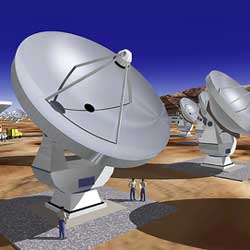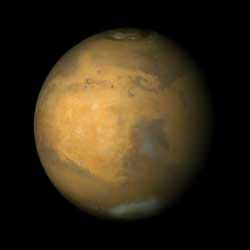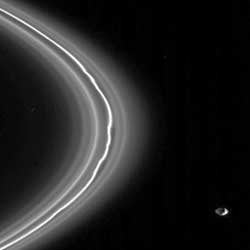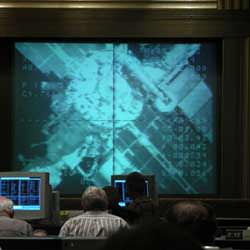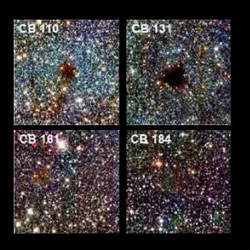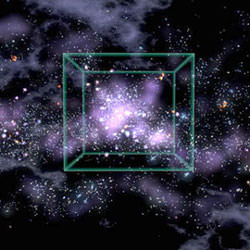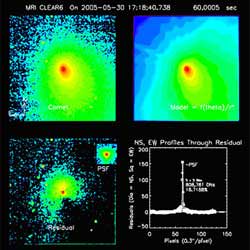
Deep Impact’s measurements of Comet Tempel 1’s nucleus. Image credit: NASA/JPL/UM. Click to enlarge.
For the first time, scientists have processed images from NASA’s Deep Impact spacecraft and clearly seen the solid body, or nucleus, of the comet through the vast cloud of dust and gas that surrounds it. The new images provide important information about the mission’s target: the “heart” of comet Tempel 1.
The images were taken at the end of May with the spacecraft’s medium resolution camera, at a distance of some 20 million miles from the comet. Unprocessed, the images are dominated by the comet’s huge cloud of dust and gas, which scientists call the coma. However, scientists used a neat photometric trick to isolate the relatively small (3-mile by 9-mile) nucleus from the comet’s coma, or atmosphere. The much larger, but less dense atmosphere was mathematically identified and then subtracted from the original images leaving images of the nucleus, the bright point in the center of the coma.
“Its exciting to see the nucleus pop out from the coma,” said University of Maryland astronomer Michael A’Hearn, who leads the Deep Impact mission. “And being able to distinguish the nucleus in these images helps us to better understand the rotational axis of the comet’s nucleus, which is helpful for targeting this elongated body.”
“This is an important milestone for the Deep Impact team,” explained Carey Lisse, a member of the Deep Impact team and leader of the effort to extract views of the nucleus from the spacecraft images. “From here on in we just watch the nucleus grow and grow and become brighter and bigger as the spacecraft closes in on the comet. We detected the nucleus a lot sooner than expected, but now we’ll be watching the nucleus all the way to impact!”
As illustrated in the attached figure, Deep Impact images taken on May 29-31 contain a well-formed coma with a detectable point source at the position of the brightest pixel. The brightness of the nucleus as determined from these images was close to that predicted from earlier observations with the Hubble and Spitzer space-telescopes and observations from large telescopes on the ground. At present, the nucleus contributes about 20 percent of the total brightness near the center of the comet.
“The early detection of the nucleus in these images helps us to set the final exposure times for our encounter observations,” said Michael Belton, deputy principal investigator for the Deep Impact Mission. “Next we need to determine, using additional nucleus detections, how the comet is rotating in space, so we can figure out what part we will hit on July 4th.”
5 – 4 – 3 – 2 – 1 – IMPACT
Deep Impact — which consists of a sub-compact-car-sized flyby spacecraft and a five-sided impactor spacecraft about the size of a washing machine — carries four instruments. The flyby spacecraft carries two imaging instruments, the medium resolution imager and the high resolution imager, plus an infrared spectrometer that uses the same telescope as the high-resolution imager. The impactor carries a single imager. Built to science team specifications by Ball Aerospace & Technologies Corp., the three imaging instruments are essentially digital cameras connected to telescopes. They record images and data before, during, and after impact.
At the beginning of July, after a voyage of some 268 million miles, the joined spacecraft will reach comet Tempel 1. The spacecraft will approach the comet and collect images and spectra of it. Then, some 24 hours before the 2 a.m. (EDT) July 4th impact, the flyby spacecraft will launch the impactor into the path of the onrushing comet. Like a copper penny pitched up into the air just in front of a speeding tractor-trailer truck, the 820-pound impactor will be run down by the comet, colliding with the nucleus at an impact speed of some 23,000 miles per hour. A’Hearn and his fellow mission scientists expect the impact to create a crater several hundred feet in size; ejecting ice, dust and gas from the crater and revealing pristine material beneath. The impact will have no significant affect on the orbit of Tempel 1, which poses no threat to earth.
Nearby, Deep Impact’s ‘flyby’ spacecraft will use its medium and high resolution imagers and infrared spectrometer to collect and send back to Earth pictures and data of the event. In addition, the Hubble and Spitzer space telescopes, the Chandra X-ray Observatory, and large and small telescopes on Earth also will observe the impact and its aftermath.
The University of Maryland, College Park, conducts the overall mission management for Deep Impact, which is a Discovery class NASA program. NASA’s Jet Propulsion Laboratory(JPL) handles project management for the Deep Impact mission. The spacecraft was built for NASA by Ball Aerospace & Technologies Corporation, Boulder, Colo.
Original Source: University of Maryland News Release


